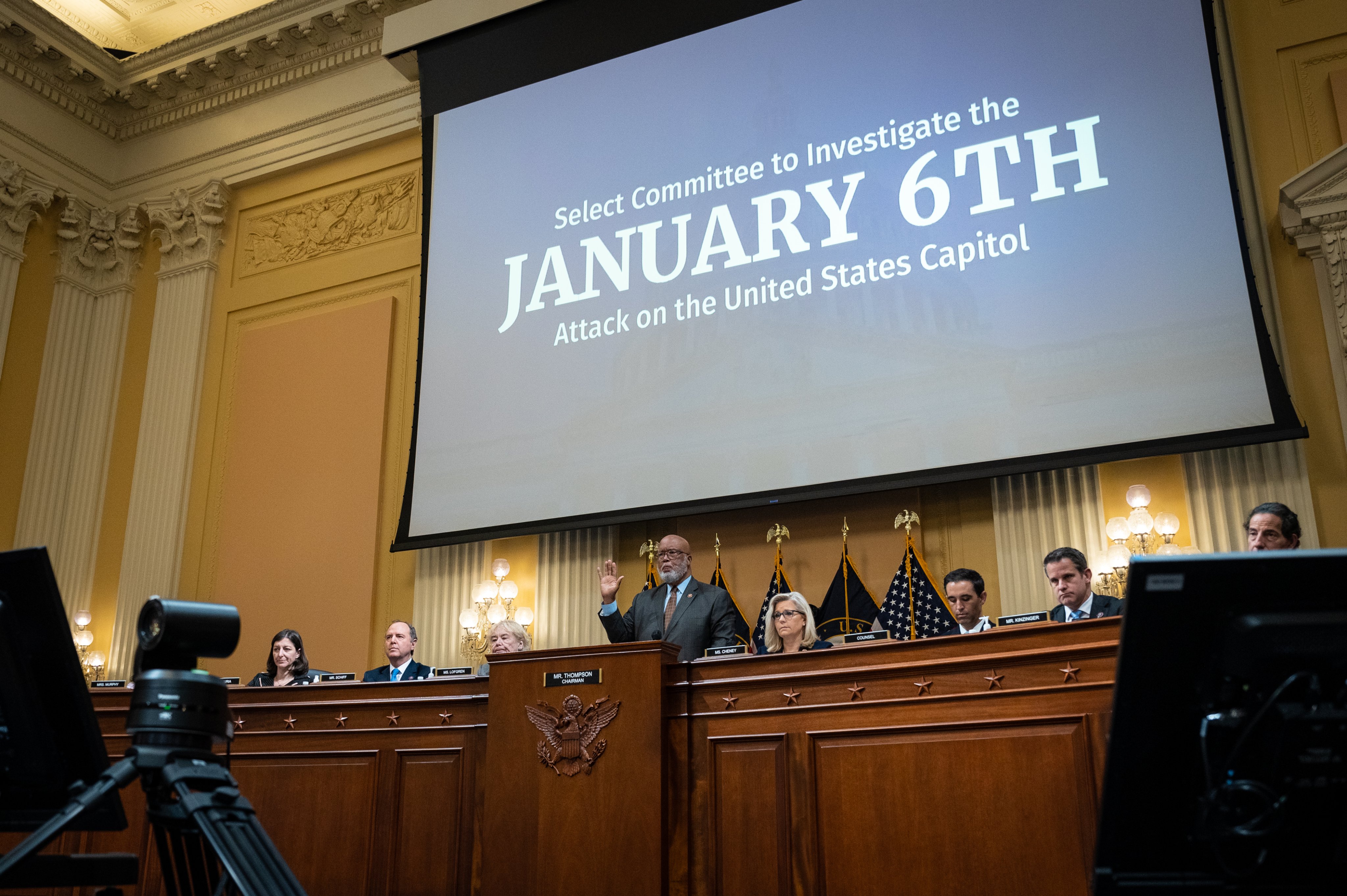Why the Jan. 6 Committee Must Reinforce the 25th Amendment
The aftermath of the attack on the Capitol exposed challenges of using the 25th Amendment. In its upcoming report, the Jan. 6 committee should clearly explain how the amendment works and propose legislative reforms to close gaps in its implementation.

Published by The Lawfare Institute
in Cooperation With

When the House Select Committee to Investigate the January 6th Attack on the United States Capitol reconvenes this fall, it’s widely expected that the 25th Amendment will be a topic of interest. Over the summer, the committee interviewed former Trump Cabinet members about possible invocations of the amendment’s Section 4—and with good reason. Following the Jan. 6 attack, serious attention turned to the possibility that the vice president and Cabinet would invoke that section of the 25th Amendment to take the powers and duties of the office from the president. The House of Representatives passed a resolution calling for the amendment’s use, and several Cabinet members reportedly contemplated taking that step.
Amid this heightened focus on the amendment, some challenges of using it became clear. Those hurdles included misconceptions about how the amendment works, ambiguity over whether acting Cabinet secretaries can participate in the process, and how the vice president’s unavailability—a possibility during the tumult of Jan. 6—makes using the amendment’s inability procedures impossible. These issues should be addressed by the committee as it contemplates legislative reforms.
In the aftermath of Jan. 6, key officials may not have fully understood the 25th Amendment’s procedures. When Marc Short, Vice President Mike Pence’s chief of staff, made comments earlier this year explaining why Pence did not move to invoke the amendment, he seemed to believe that congressional approval was required to remove the president from power.
That is not correct. The initial authority to declare an inability rests with the vice president and a majority of the Cabinet or another body that Congress can create. Congress does have responsibility for resolving disputes over whether a president is “unable.” But, because of the length of time Congress has to handle a dispute, President Trump almost certainly would have remained without the powers and duties of the office for the final two weeks of his term had the amendment been invoked.
The process for separating the president from his powers and duties without his agreement is contained in the first sentence of Section 4. It states that the vice president becomes acting president “immediately” after the vice president and a majority of the Cabinet declare the president unable.
The following parts of that section—which set forth the required procedures in the event that the president disputes others’ assessment of his or her inability—have occasionally been misunderstood, including by officials in the executive branch and Congress before and after Jan. 6. Section 4 continues, “[W]hen the President transmits … his written declaration that no inability exists, he shall resume the powers and duties of his office unless the Vice President and a majority of” the Cabinet “transmit within four days … their written declaration that the President is unable to discharge the powers and duties of his office.”
This provision creates a four-day “waiting period” when the vice president and Cabinet can reassert their declaration that the president is unable. If the vice president and Cabinet do not make that second declaration, the president returns to power after four days—or possibly sooner if the vice president and Cabinet agree. But if the vice president and Cabinet make a second declaration, the question of whose assessment of presidential inability should prevail—the president’s or the vice president and Cabinet’s—is sent to Congress to decide within 21 days after both chambers assemble. A two-thirds vote from each house is needed to keep the president out of power beyond the 21-day period.
Section 4 is designed to prevent the president from exercising the office’s powers until Congress has finished the review process. But two days after Jan. 6, House Republican leader Kevin McCarthy said that using the 25th Amendment would take “too long” due to Congress’s role in the Section 4 process. In fact, Congress would not have needed to do anything. Only 12 days remained in Trump’s term, so lawmakers could have simply let the 21-day period run out. A misconception that the president can hold power during the congressional process seemed implicit in McCarthy’s thinking.
The president’s status during Congress’s consideration of a dispute may not be the only source of confusion. As some scholars have noted, misunderstanding might also arise regarding the four-day waiting period preceding the congressional review. A critical misconception appears in a White House contingency plans binder compiled during the Reagan administration and passed on to at least the most recent Bush administration. The binder contains documents produced by the White House Counsel’s Office and the Justice Department’s Office of Legal Counsel (OLC) at various times. In several places, the plans indicate that the president might be allowed to overrule an initial inability determination by the vice president and Cabinet and immediately retake power—before potentially being removed from power again by a second declaration. The correct interpretation is embraced in an OLC opinion elsewhere in the binder, but any uncertainty could create a barrier to the amendment’s efficient use.
A full reading of Section 4 shows that the vice president serves as acting president during both the congressional review and the preceding four-day waiting period. The final clauses of Section 4 outline two possible outcomes of Congress’s consideration of a dispute: either (a) “the Vice President shall continue to discharge [the powers and duties of the presidency] as Acting President” or (b) “the President shall resume the powers and duties of his office.” This language unambiguously contemplates what Sen. Birch Bayh, the amendment’s principal architect, said: “The vice president continues to act as president until the Congress decides the issue.” The president cannot resume powers he already has, just as the vice president cannot continue discharging powers he does not have.
Multiple scholarly explorations and a 1985 OLC memo have addressed the four-day waiting period, all concluding that the president remains out of power during that period. Joel K. Goldstein’s analysis emphasizes that Section 4 states that the president returns to power “unless” a second declaration is made by the vice president and the Cabinet. If the president returned to power immediately, Section 4 would provide that he served “until”—not “unless”—a second declaration was issued. Additionally, Goldstein’s extensive review of the legislative history concludes that it “confirms in overwhelming fashion that the Vice President possesses presidential powers and duties during the four-day period.”
There is also a practical purpose for this approach: Allowing the president to reassume power immediately would let him fire some or all of the Cabinet members who agreed with the vice president to declare him unable, blocking them from issuing a second declaration.
Given this confusion, the Jan. 6 committee’s report should clearly describe how the amendment works and address some concerns that surfaced in the wake of the assault on the Capitol. The committee’s highly anticipated report will provide a prominent platform to correct misunderstandings about the amendment and an opportunity to recommend that the executive branch review its protocols and guidance for using the amendment to ensure that they are free of misconceptions.
The report should state unequivocally that the president remains out of power until the conclusion of the Section 4 process. It should explain that the president is not authorized to retake power immediately upon disagreeing with an inability declaration.
Legislation is not needed to clarify the president’s status during the Section 4 process because the amendment’s text and legislative history are sufficiently clear on that point. The committee should suggest, however, that Congress pass legislation stating that acting Cabinet secretaries are eligible to participate in the Section 4 process.
By the week after the Capitol siege, five of Trump’s 15 Cabinet secretaries were serving in an acting capacity. In other words, one-third of Senate-confirmed Cabinet secretaries had resigned, leaving lower ranking officials in charge. Secretary of State Mike Pompeo and Treasury Secretary Steve Mnuchin reportedly hesitated to support invoking the 25th Amendment because it was unclear whether acting Cabinet secretaries would have a vote.
The 25th Amendment does not specify whether acting secretaries are eligible to participate, and the history of the provision’s drafting does not provide perfect clarity. Framers of the amendment had different views about the issue. But Fordham University law professor and former dean John D. Feerick, who helped draft the amendment with Senator Bayh, suggests that the balance of the record indicates that acting secretaries can and should participate.
That is the most sensible policy. If acting secretaries are not eligible, it would create a perverse incentive for a president fearing the amendment’s invocation to fire Cabinet secretaries who might support removing him from his powers and duties. A rogue president could attempt to clear the Cabinet of any secretaries seeking to use the amendment—with no concern that the acting secretaries who would succeed them might also pursue invocation.
Finally, the Jan. 6 committee should urge Congress to close a significant gap in the 25th Amendment concerning the indispensable role of the vice president. Section 4 becomes unusable if the vice president is dead, incapacitated, or otherwise unavailable. Even if a majority of the Cabinet votes to remove the president from power, the vice president must concur.
As calls for his hanging echoed through the Capitol, Vice President Pence came within 40 feet of rioters armed with baseball bats and pepper spray as he fled for shelter. Pence remained at an underground loading dock for hours until the Secret Service deemed it safe for him to emerge.
If the vice president is dead, incapacitated, or unavailable, the next person in the presidential line of succession after the vice president should be authorized to act with the Cabinet to declare the president unable. This approach would follow the 25th Amendment’s model, which makes the person who would serve as acting president—the vice president—an essential participant in declaring a presidential inability. Drawing on the existing constitutional procedures would enhance the process’s legitimacy. Additionally, this approach would prevent the elevation of an official who did not agree that they were prepared to serve as acting president. It is critical to have an acting president who is ready to take the job, especially when their succession occurs at a moment of national crisis.
But, under existing law, there are drawbacks to allowing the successor after the vice president to participate in declaring the president unable. On Jan. 6, House Speaker Nancy Pelosi, a Democrat, was the next official in the line of succession. Many in the public and government might not accept it as legitimate for a political opponent of the president to declare an inability and, in effect, trigger a change in party control of the White House.
Senator Bayh himself worried about a potential dual-vacancy scenario during Watergate after Vice President Spiro Agnew resigned. Had President Richard Nixon resigned or been removed from office before a new vice president was nominated and confirmed by the Senate, Speaker Carl Albert, a Democrat, would have been next in line. Bayh was concerned that the presidency would go to the “party opposite,” heightening the perception that Nixon’s removal was politically motivated. To counter this concern, there was talk of Albert resigning as speaker so that a Democratic House could elect Gerald Ford, the Republican leader, as speaker, placing him in the line of succession.
A potential change in party in the White House is not the only problem. Some scholars argue that legislators are constitutionally ineligible to succeed to the presidency. Those legal questions could prompt challenges to legislators’ succession.
To avoid the political sensitivities and constitutional questions, Congress should revise the 1947 Presidential Succession Act to make Cabinet secretaries the next successors after the vice president, in order of their department’s seniority. Cabinet secretaries already compose the line of succession following the speaker and Senate president pro tempore.
The 25th Amendment has served the country well. During Watergate, another trying time for the country, it provided stability. The amendment’s vice presidential replacement process let Nixon appoint a fellow Republican, Gerald Ford, to the vice presidency after Agnew’s resignation. Without the assurance that another Republican would succeed him, Nixon may have been less inclined to resign, and the country could have been delayed in moving past its “national nightmare.”
The amendment may have modulated Trump’s behavior, too. In a video released on Jan. 7, 2021, Trump committed to leaving office and “ensuring a smooth, orderly, and seamless transition of power” to the Biden administration. Former White House staffer Cassidy Hutchinson told the select committee that Trump gave the remarks in part to stop discussions about invoking the 25th Amendment.
Now, the Jan. 6 committee can help ensure that the 25th Amendment continues its legacy of safeguarding stable presidential leadership. Although the committee cannot itself implement new policies, its recommendations could have an influential impact in Congress and the executive branch. And, just as importantly, the committee’s report provides an ideal opportunity for civic education about the 25th Amendment and its role during a national crisis






